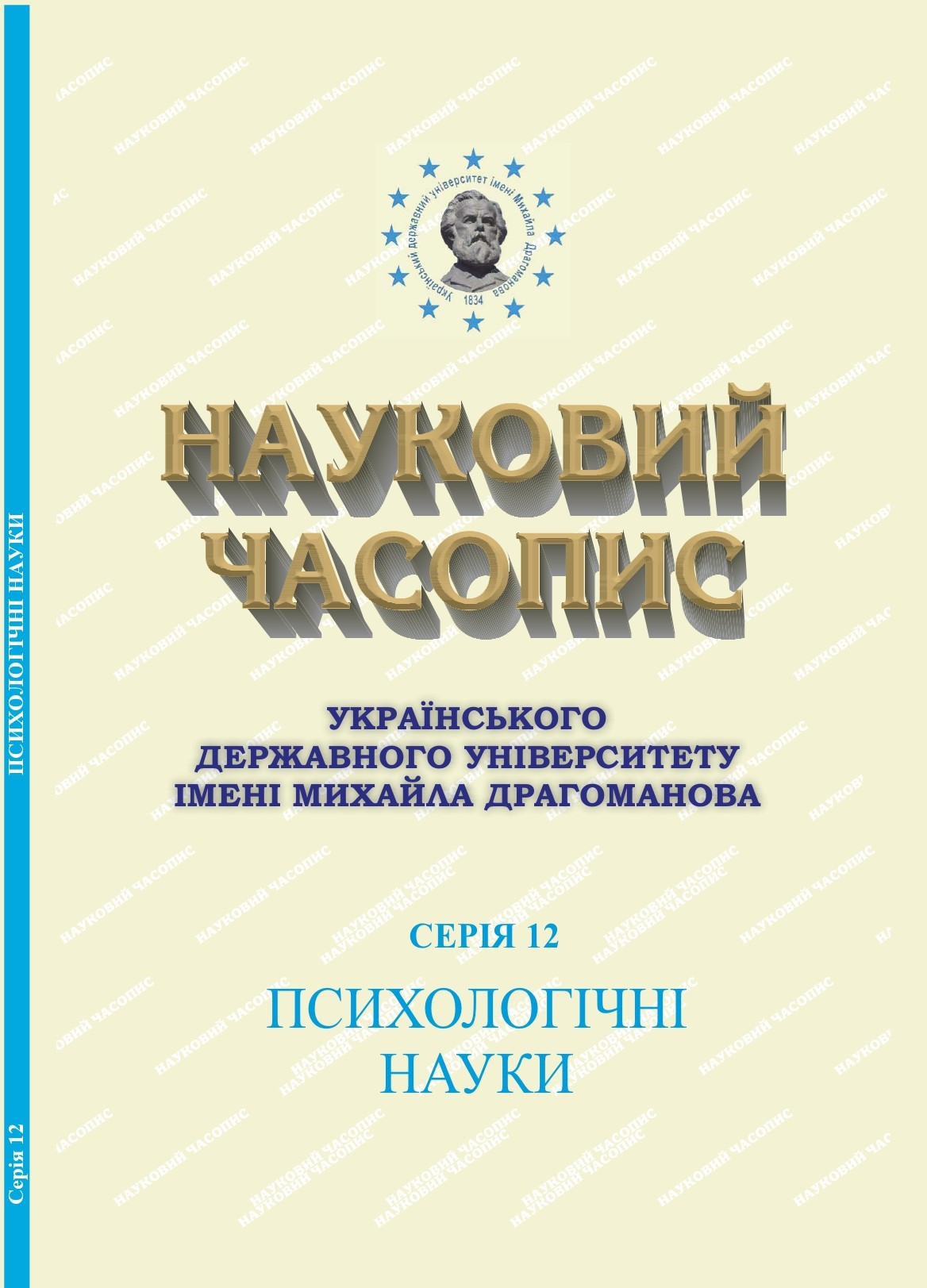FORMATION OF NATIONAL IDENTITY AMONG STUDENTS DURING A PERIOD OF FULL-SCALE WAR
DOI:
https://doi.org/10.31392/UDU-nc.series12.2023.22(67).10Keywords:
self- identity, youth age, social identity, ethnic identity, civic identity, patriotism, psychological consequences of war.Abstract
Objective. The article is focused on the analysis of specific features and transformations of students’ national identity during the period of the full-scale invasion. Research methods. Two surveys of students of humanitarian specialties were conducted with an interval of two years (2021 and 2023). The total sample consisted of 224 respondents aged 16-23, among them 180 girls and 44 boys. For the empirical study, we used the self-determination test “Who am I?” by Kuhn and McPartland, the modified scale “Expression of ethnic identity” by Finney, the questionnaire “Civic identity” by
I.R. Petrovska. The average indicators of the formation of national identity components before and after the full-scale invasion were compared. By analyzing students’ free self-descriptions, it was determined that the category of national identity is most often represented by the nouns “Ukrainian”, “patriot”, “citizen of Ukraine”. The prevalence of responses reflecting national or ethnic identity after a full-scale invasion was found to be increasing among students. The ranking position of these answers has shifted to the top of the list, i.e. the national characteristic has become a priority over other social roles of young men. There has been a significant increase in the cognitive and affective components of ethnic identity, indicators of patriotism and civic activity of students, but the tendency to emigrate remained at the same level. Conclusions. After the beginning of the full-scale invasion, pro-Ukrainian patriotic sentiments and their behavioral implementation have significantly increased in the student environment. Ethnic, national, civil and local identities have become the subject of comprehensive reflection of young men and women, a conscious and subjectively significant part of self-concept. A characteristic feature of self-identity construction during this period is that, in addition to the image of “I am Ukrainian”, it includes the image of opposition (a common enemy). The results obtained should be taken into account in the educational process with students, as they are useful for understanding the psychological changes in Ukrainian society caused by life in the conditions of a full-scale war.
References
- Arbienina, V.L. (2012). Sutnist, proiavy ta chynnyky formuvannia hromadianskoi identychnosti ukrainskoho studentstva [The essence, manifestations and factors of the formation of the civic identity of Ukrainian students]. In L. Arbienina & L.H. Sokurianska (Eds.). Ukrainske studentstvo u poshukakh identychnosti - Ukrainian studentship in search of identity. (рр. 42-74). Kharkiv : KhNU imeni V.N. Karazina [in Ukrainian].
- Hora, O.V. (2012). Metodyka doslidzhennia rivnia sformovanosti natsionalnoi identychnosti studentiv [Methodology for researching the level of formation of students' national identity]. Naukovi zapysky KDPU imeni Volodymyra Vynnychenka. Seriia : Pedahohichni nauky - Scientific notes of Volodymyr Vinnichenko Kirovohrad State Pedagogical University. Series: Pedagogical Sciences, 103, 90–100. http://nbuv.gov.ua/UJRN/Nz_p_2012_103_14 [in Ukrainian].
- Dembitskyi, S. (2022). Pokaznyky natsionalno-hromadianskoi ukrainskoi identychnosti [Indicators of national-civic Ukrainian identity]. Press Release. Institute of Sociology. National Academy of Sciences of Ukraine. URL: https://www.kiis.com.ua/?lang=ukr&cat=reports&id=1131&page=1 [in Ukrainian].
- Kukharuk, O.Iu. (2020). Osoblyvosti etnichnoi identychnosti predstavnykiv riznykh etnomovnykh hrup ukrainskoho studentstva [Peculiarities of ethnic identity of representatives of different ethnolinguistic groups of Ukrainian students]. Candidate’s thesis. Kyiv [in Ukrainian].
- Lukomska, S.O. (2015). Fenomen identychnosti osobystosti v suchasnykh zarubizhnykh doslidzhenniakh [The phenomenon of personal identity in modern foreign studies]. Osobystist u rozvytku: psykholohichna teoriia i praktyka – Personality in development: psychological theory and practice (monograph) / In D. Maksymenkо, V.L. Zlyvkov & S.B. Kuzikovа (Eds.) (рр. 187–206). Sumy : Vyd-vo SumDPU imeni A.S. Makarenka [in Ukrainian].
- Petrovska, I.R. (2016). Rozrobka ta psykhometrychna perevirka opytuvalnyka "Hromadianska identychnist" [Development and psychometric testing of the "Civic Identity" questionnaire.] . Naukovyi visnyk KDU. Seriia: Psykholohichni nauky - Scientific Bulletin of Kherson State University. Series: Psychological Sciences, 1(1), 70–75. http://nbuv.gov.ua/UJRN/nvkhp_2016_1%281%29__14 [in Ukrainian].
- Piontkovska, D.V. (2017). Psykholohichni osoblyvosti rozvytku natsionalnoi identychnosti studentskoi molodi [Psychological features of the development of the national identity of student youth]. Candidate’s thesis. Kamianets-Podilskyi [in Ukrainian].
- Synelnykov, R.Iu. (2018). Diahnostyka sformovanosti hromadianskoi identychnosti ukrainskoi molodi [Diagnostics of the formation of the civic identity of Ukrainian youth]. Orhanizatsiina psykholohiia. Ekonomichna psykholohiia - Organizational psychology. Economic Psychology, 3(14), 87–96. https://doi.org/10.31108/2.2018.3.14.10 [in Ukrainian].
- Spivak, L.M. (2020). Zviazok natsionalnoi afiliatsii z natsionalnoiu identychnistiu studentskoi molodi [The connection of national affiliation with the national identity of student youth]. Problemy suchasnoi psykholohii – Problems of modern psychology, 1(17), 176–180. https://doi.org/10.26661/2310-4368/2020-1-21 [in Ukrainian].
- Shebanova, V.I., Dementieva, K.H., & Chykur, L.D. (2022). Vymiry etnichnoi tolerantnosti ukrainskoi studentskoi molodi [Dimensions of ethnic tolerance of Ukrainian student youth]. Naukovyi visnyk Khersonskoho derzhavnoho universytetu. Seriia «Psykholohichni nauky» – Scientific Bulletin of Kherson State University. Series "Psychological Sciences", 2, 48–54. https://doi.org/10.32999/ksu2312-3206/2022-2-7 [in Ukrainian].
- Barrington, L. (2021). Citizenship as a cornerstone of civic national identity in Ukraine. Post-Soviet Affairs, Taylor & Francis Journals, 37(2), 155–173. https://doi.org/10.1080/1060586X.2020.1851541
- Barth, F. (Ed.). (1998). Introduction. Ethnic Groups and Boundaries: The Social Organization of Cultural Difference (рр. 9–38). Long Grove: Waveland Press.
- Brubaker, R., & Cooper, F. (2000). Beyond “identity”. Theory and Society, 29(1), 1–47. https://doi.org/10.1023/A:1007068714468
- Erikson, E. (1968). Identity, youth and crisis. New York : Norton Company.
- Kuhn, M.H., & McPartland, T.S. (1954). An empirical investigation of self-attitudes. American Sociological Review, 19, 68–76. https://doi.org/10.2307/2088175
- Petrovska, I.R. (2019). Measuring civic identity: difficulties and solution. In Psychology and pedagogy in XXI century: methodological framework of the activities of psychologist and educator. (рр. 62–82). Lviv-Toruń : Liha-Pres. https://doi.org/10.36059/978
- Phinney, J.S. (1993). A three-stage model of ethnic identity development in adolescence. In M. E. Bernal & G. P. Knight (Eds.), Ethnic identity: Formation and transmission among Hispanics and other minorities (pp. 61–79). State University of New York Press.
- Shulman, S. (2004). The Contours of Civic and Ethnic National Identification in Ukraine. Europe-Asia Studies, 56(1), 35–56. http://www.jstor.org/stable/4147437

